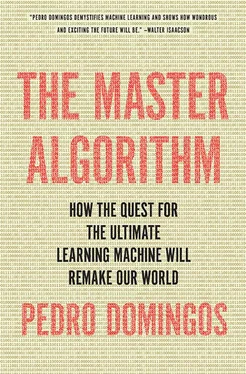The reason lazy learning wins is that forming a global model, such as a decision tree, is much harder than just figuring out where specific query points lie, one at a time. Imagine trying to define what a face is with a decision tree. You could say it has two eyes, a nose, and a mouth, but what is an eye and how do you find it in an image? What if the person’s eyes are closed? Reliably defining a face all the way down to individual pixels is extremely difficult, particularly given all the different expressions, poses, contexts, and lighting conditions a face could appear in. Instead, nearest-neighbor takes a shortcut: if the image in its database most similar to the one Jane just uploaded is of a face, then so is Jane’s. For this to work, the database needs to contain an image that’s similar enough to the new one-for example, a face with similar pose, lighting, and so on-so the bigger the database, the better. For a simple two-dimensional problem like guessing the border between two countries, a tiny database suffices. For a very hard problem like identifying faces, where the color of each pixel is a dimension of variation, we need a huge database. But these days we have them. Learning from them may be too costly for an eager learner, which explicitly draws the border between faces and nonfaces. For nearest-neighbor, however, the border is implicit in the locations of the data points and the distance measure, and the only cost is at query time.
The same idea of forming a local model rather than a global one applies beyond classification. Scientists routinely use linear regression to predict continuous variables, but most phenomena are not linear. Luckily, they’re locally linear because smooth curves are locally well approximated by straight lines. So if instead of trying to fit a straight line to all the data, you just fit it to the points near the query point, you now have a very powerful nonlinear regression algorithm. Laziness pays. If Kennedy had needed a complete theory of international relations to decide what to do about the Soviet missiles in Cuba, he would have been in trouble. Instead, he saw an analogy between that crisis and the outbreak of World War I, and that analogy guided him to the right decisions.
Nearest-neighbor can save lives, as Steven Johnson recounted in The Ghost Map . In 1854, London was struck by a cholera outbreak, which killed as many as one in eight people in parts of the city. The then-prevailing theory that cholera was caused by “bad air” did nothing to prevent its spread. But John Snow, a physician who was skeptical of the theory, had a better idea. He marked on a map of London the locations of all the known cases of cholera and divided the map into the regions closest to each public water pump. Eureka: nearly all deaths were in the “metro area” of one particular pump, located on Broad Street in the Soho district. Inferring that the water in that well was contaminated, Snow convinced the locals to disable the pump, and the epidemic died out. This episode gave birth to the science of epidemiology, but it’s also the first success of the nearest-neighbor algorithm-almost a century before its official invention.
With nearest-neighbor, each data point is its own little classifier, predicting the class for all the query examples it wins. Nearest-neighbor is like an army of ants, in which each soldier by itself does little, but together they can move mountains. If an ant’s load is too heavy, it can share it with its neighbors. In the same spirit, in the k -nearest-neighbor algorithm, a test example is classified by finding its k nearest neighbors and letting them vote. If the nearest image to the new upload is a face but the next two nearest ones aren’t, three-nearest-neighbor decides that the new upload is not a face after all. Nearest-neighbor is prone to overfitting: if we have the wrong class for a data point, it spreads to its entire metro area. K -nearest-neighbor is more robust because it only goes wrong if a majority of the k nearest neighbors is noisy. The price, of course, is that its vision is blurrier: fine details of the frontier get washed away by the voting. When k goes up, variance decreases, but bias increases.
Using the k nearest neighbors instead of one is not the end of the story. Intuitively, the examples closest to the test example should count for more. This leads us to the weighted k -nearest-neighbor algorithm. In 1994, a team of researchers from the University of Minnesota and MIT built a recommendation system based on what they called “a deceptively simple idea”: people who agreed in the past are likely to agree again in the future. That notion led directly to the collaborative filtering systems that all self-respecting e-commerce sites have. Suppose that, like Netflix, you’ve gathered a database of movie ratings, with each user giving a rating of one to five stars to the movies he or she has seen. You want to decide whether your user Ken will like Gravity , so you find the users whose past ratings correlate most highly with his. If they all gave Gravity high ratings, then probably so will Ken, and you can recommend it to him. If they disagree on Gravity , however, you need a fallback point, which in this case is ranking users by how highly they correlate with Ken. So if Lee’s correlation with Ken is higher than Meg’s, his ratings should count for correspondingly more. Ken’s predicted rating is then the weighted average of his neighbors’, with each neighbor’s weight being his coefficient of correlation with Ken.
There’s an interesting twist, though. Suppose Lee and Ken have very similar tastes, but Lee is grumpier than Ken. Whenever Ken gives a movie five stars, Lee gives three; when Ken gives three, Lee gives one, and so on. We’d like to use Lee’s ratings to predict Ken’s, but if we just do it directly, we’ll always be off by two stars. Instead, what we need to do is predict how much Ken’s ratings will be above or below his average, based on how much Lee’s are. And now, since Ken is always two stars above his average when Lee is two stars above his, and so on, our predictions will be spot on.
You don’t need explicit ratings to do collaborative filtering, by the way. If Ken ordered a movie on Netflix, that means he expects to like it. So the “ratings” can just be ordered/not ordered, and two users are similar if they’ve ordered a lot of the same movies. Even just clicking on something implicitly shows interest in it. Nearest-neighbor works with all of the above. These days all kinds of algorithms are used to recommend items to users, but weighted k -nearest-neighbor was the first widely used one, and it’s still hard to beat.
Recommender systems, as they’re also called, are big business: a third of Amazon’s business comes from its recommendations, as does three-quarters of Netflix’s. It’s a far cry from the early days of nearest-neighbor, when it was considered impractical because of its memory requirements. Back then, computer memories were made of small iron rings, one per bit, and storing even a few thousand examples was taxing. How times have changed. Nevertheless, it’s not necessarily smart to remember all the examples you’ve seen and then have to search through them, particularly since most are probably irrelevant. If you look back at the map of Posistan and Negaland, you may notice that if Positiville disappeared, nothing would change. The metro areas of nearby cities would expand into the land formerly occupied by Positiville, but since they’re all Posistan cities, the border with Negaland would stay the same. The only cities that really matter are the ones across the border from a city in the other country; all others we can omit. So a simple way to make nearest-neighbor more efficient is to delete all the examples that are correctly classified by their neighbors. This and other tricks enable nearest-neighbor methods to be used in some surprising areas, like controlling robot arms in real time. But needless to say, they’re still not the first choice for things like high-frequency trading, where computers buy and sell stocks in fractions of a second. In a race between a neural network, which can be applied to an example with only a fixed number of additions, multiplications, and sigmoids and an algorithm that needs to search a large database for the example’s nearest neighbors, the neural network is sure to win.
Читать дальше












